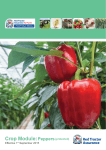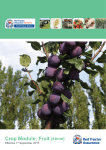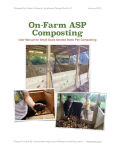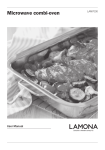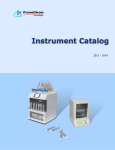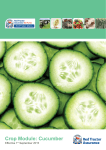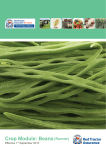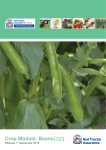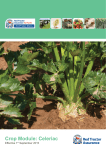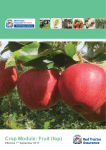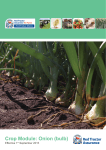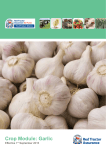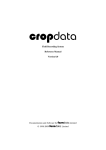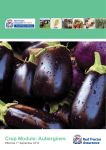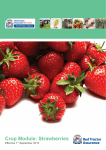Download Crop Module: Fruit (bush)
Transcript
Crop Module: Fruit (bush) Effective 1st September 2015 Welcome T his crop specific module for bush fruit has been written to complement and avoid duplicating the generic principles of the Red Tractor Farm Assurance Fresh Produce Scheme standards. It is advisable to read the Red Tractor Farm Assurance Fresh Produce standards before reading this crop specific module. This module is designed to stimulate thought in the mind of the reader. It contains crop specific guidance and standards, where applicable, in addition to the requirements stated in the generic Fresh Produce standards. Within this module the important requirements outlined in the crop specific standards section will be verified during the Red Tractor Farm Assurance assessment and compliance will form a part of the certification/approval decision. Disclaimer and trade mark acknowledgement Although every effort has been made to ensure accuracy, Assured Food Standards does not accept any responsibility for errors and omissions. Trade names are only used in this module where use of that specific product is essential. All such products are annotated® and all trademark rights are hereby acknowledged. Notes: Pesticide Information General Introduction Following a systematic approach will help growers identify and manage the risks involved in crop production. This module is based on a typical crop production process and food safety, health & safety, environmental and quality hazards are identified. Appropriate controls may then be established to minimise risk. Food safety and health & safety issues always take precedent over quality and environmental controls. The layout of this module follows the same structure as that used in the Red Tractor Farm Assurance Fresh Produce Standards. The content of the module is reviewed prior to the issue of updated editions. The review process considers both new developments and all relevant technology which has emerged since the last review was completed and which have been found to be both workable by the grower and beneficial to the environment. The aim is to transfer such information and technologies to growers. Acknowledgements Red Tractor Farm Assurance Fresh Produce gratefully acknowledges the contribution of all consultees in the preparation of this protocol, particularly members of British Summer Fruits, John Atwood of ADAS UK Ltd and Rob Saunders of Suntory. The Red Tractor Fresh Produce team has been working with Fera to provide tailored access to the LIAISON database for all Red Tractor Fresh Produce members. This system allows individual growers access to all information for plant protection products approved for use under the Red Tractor Fresh Produce Scheme. LIAISON can be accessed under the Produce tab via the “Checkers and Services” page where you will also find a user manual. Searches will be filtered specifically for the crops for which you are registered. Once you have logged onto the site and clicked on the LIAISON hyperlink you will be directed to the LIAISON home screen. You will need a username and password and these will be sent once you have registered: http://assurance.redtractor.org.uk/rtassurance/ services/Registration/members.eb . 1 Red Tractor Assurance for Farms – Crop-specific Module: Fruit (bush) © Assured Food Standards 2015 Content Contents ADDITIONAL REQUIREMENTS AGAINST CURRENT STANDARDS 02 CROP SPECIFIC STANDARDS02 SITE AND SOIL MANAGEMENT 03 ENVIRONMENTAL PROTECTION AND CONTAMINATION CONTROL04 NUTRITION07 IRRIGATION07 HARVEST AND STORAGE08 RESIDUES AND CONTAMINANTS08 APPENDIX 1: TYPICAL FERTILISER APPLICATIONS FOR BLACKCURRANTS09 APPENDIX 2: GUIDELINES ON MINIMISING PESTICIDE RESIDUES10 ADDITIONAL REQUIREMENTS AGAINST CURRENT STANDARDS STANDARDS HOW YOU WILL BE MEASURED RECORDS (to be kept for 2 years) n Crop IM.b Regular crop inspections must be undertaken and recorded inspection records/ diary notes and subsequent recommendations CROP SPECIFIC STANDARDS None for this crop module Red Tractor Assurance for Farms – Crop-specific Module: Fruit (bush) © Assured Food Standards 2015 2 GUIDANCE CHOICE OF VARIETY OR ROOTSTOCK AND PLANT HEALTH CERTIFICATION PLANTING MATERIAL For successful Ribes production it is vital to plant stocks which are virus free and of a high health status. Planting material should be obtained from an approved nurseryman where the material has been certified under the Plant Health Propagation Scheme (PHPS) or a recognisable comparable scheme with quality standards that meet the specifications for which it is intended. Where self-propagation of planting material is carried out (where approved), however limited, it is extremely important that this material is grown in a manner as to minimise the risk of infection from viruses and pests from commercial plantations. Where growers require assurances from propagators that plants have been raised under the auspices of the Red Tractor Farm Assurance Fresh Produce Scheme, they should request a verification number from their propagator. SITE AND SOIL MANAGEMENT SITE HISTORY Correct site selection is an important factor if a plantation is to produce viable yields of optimum quality fruit. Some blackcurrant varieties require a frost-free site although most modern varieties have a degree of frost tolerance. Sites should slope with no obstructions at the bottom to encourage air drainage. Shelter from cold winds during flowering is important; to prevent physical damage and to encourage a warmer microclimate that in turn will encourage pollination and the presence of pollinating insects. 3 Phomopsis dead arm such as Ben Tirran, Ben Dorain and Ben Avon should only be grown on the best soil types, preferably with irrigation to avoid stress. Gooseberries are less tolerant of heavy soils than blackcurrants. A well-maintained drainage system will reduce the impact of some of these problems. Adequate soil preparation prior to the planting of new material is important to maintain soil structure. Cultivation of very dry soil can result in slumping and capping while cultivation of excessively wet soil can result in smearing and compaction. These problems can significantly reduce the success of establishment. When selecting fields for bush fruit production, consideration should be given to soil structure, drainage, texture, pH, depth, air movement, exposure of the site to prevailing winds, susceptibility to spring frosts, incidence of perennial weeds and proximity of other bush fruit plantations with existing levels of pests and disease. ROTATIONS Previous cropping Previous cropping and incidence of perennial weeds should be considered when siting new plantations. Where grass or blackcurrants have been grown previously, a nematode test should be undertaken to assess populations of free-living root feeding nematode species e.g. Pratylenchus that can cause growth stunting. Avoid planting blackcurrants where vine weevil populations have been found in any previous crop. A break crop can substantially reduce numbers and will allow a far better establishment. Where Armillaria has been known to exist, then blackcurrants should not be planted until 10 years after the last known host crop has been removed. The most important factor when considering a site is the proximity of other plantations, particularly if, in the case of blackcurrants, they are infested with blackcurrant gall mite. Consideration should be given to the level of infestation and the intended variety that is to be planted. New plantations should not be planted adjacent to an existing plantation unless, it is itself a young plantation. Ideally new sites should be planted as far as reasonably possible from existing plantations. Rotations Blackcurrants can be grown on a wide range of soil types, though lighter soils will require the provision of irrigation. Pure sands should be avoided due to poor availability of water. Heavy clays are also unsuitable due to possible problems of compaction, poor aeration and waterlogging. Blackcurrant varieties susceptible to Soil sterilisation Ideally blackcurrant crops should be rotated. In practice, with the problems of gall mite and the reduction in the life of plantations this is proving more difficult to accommodate. If a plantation has to be replanted, then there should be a minimum break of one year at least to give an opportunity to control perennial weeds or regrowth of old roots and debris. Soil sterilisation is not practised in the commercial production of blackcurrants as crop rotation is cheaper, easier and more efficient. Site selection plays a far more important role in controlling pests and diseases. Red Tractor Assurance for Farms – Crop-specific Module: Fruit (bush) © Assured Food Standards 2015 ENVIRONMENTAL PROTECTION & CONTAMINATION CONTROL PEST, DISEASE AND WEED CONTROL Pests and diseases Introduction Experience suggests that an integrated approach with emphasis on prevention rather than cure give the best results. In this way, pesticide inputs can be minimised. The insect pests and diseases causing greatest yield and quality loss to blackcurrants are gall mite/ reversion, aphid, sawfly, leaf-curling midge, vine weevil, two-spotted spider mite, capsids, tortrix caterpillar, winter moth, powdery mildew, Phomopsis (dead arm), Botrytis and leaf spot. The insect pests and diseases causing greatest yield and quality loss to gooseberries and Redcurrants are vine weevil, gooseberry sawfly, powdery mildew, Botrytis, leaf spot, Phytophthora root rot and Eutypa (dead arm). An integrated approach should be adopted to achieve optimum control involving the following management steps. Good management and planning a. Careful site selection is important b. Crop rotations to reduce the build-up of pest and disease infestations c. Where appropriate use varieties that are resistant or partially resistant to pests and disease Cultural prevention techniques 1. Roguing is an important practice to identify and then remove those bushes which have been infected with the “reversion” virus. Ideally the emerging flower buds (the “grapes”) should be inspected just prior to flowering and the leaves inspected during fruit development. 2. Promoting crop health by reducing stress through good irrigation scheduling whilst optimising nutrient availability through soil analysis (and leaf where necessary) and the appropriate and accurate application of fertiliser. Corrective action Where the above have failed, adopt the following approach: a. Regular monitoring is important to identify problems in their early stages, which are then more capable of being controlled. The effect of prevailing weather conditions should also be considered. b. Where corrective action is required, biological and natural methods of pest and disease control, if available, must be considered. Where thresholds have been established then these should be referred to. c. Where biological or natural control is not possible, chemical control, if available should be used, whilst always considering the following: n Use the least toxic and persistent product with due respect to its ecotoxicity n Use the most selective product to biological control agents and naturally occurring beneficial organisms such as bees and other pollinating insects n Use appropriate application methods with effectively maintained equipment, and spot treating wherever possible. Cultural control i. Site selection Powdery mildew, Botrytis and leaf spot are the principal diseases that affect blackcurrants. Site selection has limited effect on these diseases however, it is unwise to plant a new crop adjacent to one which is particularly prone to powdery mildew or leaf spot. For Botrytis, it is important to choose a site with good air movement and circulation to prevent the build-up of moist air. Where possible avoid planting blackcurrants close to an existing plantation which is infested with big bud mite. Crops should not be planted on sites with existing infestations of vine weevil or adjacent to crops such as strawberries, ornamentals, or blackcurrant crops, which are known to be infested. Gooseberry crops should not be planted on sites with existing infestations of vine weevil or adjacent to crops such as strawberries, blackcurrants, ornamentals or other redcurrant or gooseberry crops that are known to be infected. Sites where gooseberries have been previously lost to Phytophthora infection should also not be used. Red Tractor Assurance for Farms – Crop-specific Module: Fruit (bush) © Assured Food Standards 2015 4 ii. Rotations It is unwise to replant an old plantation with existing infestation of vine weevil, or nematodes. Always rotate plantations wherever possible. iii. Machinery/equipment If fields differ in levels of infection from pest and diseases it is always better to carry out the mechanical operations in the least affected plantation first, leaving the most affected to last thereby minimising the risk of spreading the infection. It is very easy to transfer pests from one plantation to another, either directly on tractors or sprayers, or indirectly by carrying leaf and flower buds around a farm. iv. Irrigation Bushes under stress due to drought and lack of water uptake are more susceptible to two-spotted spider mite infestation, as well as some diseases such as Phomopsis dead arm. Reduce stress by scheduling irrigation. In all cases during flowering, any irrigation should be kept to a minimum to avoid the spread of Botrytis cinerea (grey mould) on developing flowers. Furthermore, infection at the flowering stage is known to initiate the production of ethylene, which causes “run-off”. v. Mulches The use of a mulch is an important aid in the establishment of new plantations. Where vine weevil is known to have inhabited a site, however they are best avoided. Mulching reduces the need for herbicides in bush row and helps to conserve moisture. The use of coloured polythene mulches, through which the crop is planted, has proved successful in reducing the need for sterilisation by preventing weed growth. They also act as a barrier to disease infection of the lower leaves from the soil and white mulches improve plant quality through light reflection. Clear polythene mulches have been shown to enhance root growth, but these do not provide weed suppression. vi.Grass tractor alleys Ideally the tractor alleys should be grassed down. This would reduce the levels of compaction caused by heavy machinery and encourage ground beetles. Herbicide applications are reduced and soil erosion is eliminated on slopes. A wider alley might be required, particularly on strong soils and/or where vigorous cultivars are to be grown. 5 In practice in high rainfall areas excessive growth of grass and herbs in the alleyways may lead to problems of Botrytis and fruit quality, dependent on varietal habit. In some circumstances, sowing low vigour grasses or the use of weed free alleyways may be preferable. vii.Trash removal On some farms, sweeping trash from under the bush is practised. This operation is done at the same time as pulverising the prunings. Whilst it may have the effect of reducing overwintering spores on leaf debris, the main reason is to reveal the bare soil so residual herbicide activity is far more effective. Integrated control This involves the integration of cultural, biological and chemical control methods to achieve both optimum control and a reduction in pesticide usage. Regular crop monitoring is essential at least once every two weeks during the growing season by specialists or trained farm staff. The main pests that should be monitored are aphids, big bud mite, leaf curling midge, sawfly, two-spotted-spider-mite, vine weevil and woolly currant scale. Minor pests can also cause damage and should be monitored as damage occurs. As yet, few integrated control measures have been developed for blackcurrant diseases. However, several principles should be adhered to: i.There is only one approved biological control method at present for fungal diseases, Bacillus subtilis, approved for control of Botrytis. In addition, the cultural controls outlined above should be carefully observed. ii. There are three major diseases. These are powdery mildew, leaf spot and Botrytis. Established infections are extremely difficult to eradicate. Prophylactic chemical treatments will probably have to be applied. Fortunately most of the major commercial blackcurrant cultivars are resistant to powdery mildew. It is known that there is a greater risk of infection of leaf spot and Botrytis in wet and warm conditions. Risk of powdery mildew increases with higher temperatures up to 25oC then is reduced. Spray intervals and dose rates can be adapted to suit conditions at the time. iii. Before applying fungicides, ensure that you use the product which is safest to the environment, natural predators and introduced biological control organisms as well as being efficacious for the particular disease concerned. Red Tractor Assurance for Farms – Crop-specific Module: Fruit (bush) © Assured Food Standards 2015 iv. All applications must be applied within the parameters given on the product label or extension of authorisation for minor use (EAMU). Biological control The use of predatory and parasitic organisms for crop pest control has been developed extensively for glasshouse crops during the past decade. Similar principles are now being applied to outdoor crops and many predatory insects (both naturally occurring and introduced) have now been successfully adopted on outdoor soft fruit crops. On blackcurrants however, biocontrol has not been widely taken up due to the historical reliance upon broad spectrum insecticides for certain key pests and more recently the use of lambda-cyhalothrin for leaf midge. Chemicals such as these are harmful to most beneficial insects and leaf residues can last for some time. However, with the increasing use of sulphur products to control gall mite and the adoption of new varieties resistant to this pest, the use of biocontrol is now likely to have more potential. Some success has been achieved locally, using the predatory mite Phytoseiulus persimilis to control two-spotted spider mites. Results in general have been variable due to fluctuating weather patterns. Naturally occurring predators include Amblyseius, Aphidoletes aphidimyza, Syrphidae-hoverfly larva, Neuroptera-lacewing larva, Coccinellidae-ladybirds and their larva, Feltiella acarisuga and Typhlodromus pyri. More recently Beauveria bassiana has become available to growers for caterpillar and whitefly control in protected crops. Grass alleys appear to encourage higher population levels of Coleoptera-beetles, which are voracious vine weevil predators that help to maintain vine weevil at a low level. The introduction of gall mite and reversion resistant varieties has enabled an overall reduction in the use of insecticides, on sites where the pressure from mite infection is low. This reduction has led to a shift in the pattern of pest incidence, which in turn has increased demands on those monitoring the crop. A program of minimum chemical applications can be balanced with the use of naturally occurring predators, and it is the responsibility of all growers to remain in touch with these developments. Chemical control Chemicals should be used as part of an integrated pest and disease management programme including cultural, biological and chemical control. Regular monitoring of bush fruit crops should be made at least fortnightly through the growing season and a written record must be kept of observations made and subsequent recommendations. If a product is to be used under the terms of an existing EAMU the relevant “Notice of Approval” documents must be obtained and read before applying the product. At all other times abide by all label restrictions. All blackcurrants that are under contract to Suntory will be subject to samples being taken for residue analysis, at the point of despatch, during the harvesting period, with a minimum of one sample per farm. Refer to the Generic Guidance Notes for details of laboratories. It is critical that all label recommendations are adhered to so MRLs are not breached. Post-harvest If vine weevil have been found in the crop, it is recommended that suitable control measures be carried out at this stage before any replanting. WEED CONTROL Cultural control Cultivations between rows are an acceptable method of weed control on bare soil crops. Polythene soil mulches may be used to suppress weeds and reduce the need for herbicides. At the end of the plantation’s commercial life any remaining non-biodegradable mulch should be removed from the field, however, this task should ideally have been carried out during the lifetime of the plantation. Polythene materials must be disposed of in a legal and environmentally responsible manner. Do not burn or bury polythene on the farm. Wherever possible, polythene materials should be recycled. Chemical control The control of weeds using residual and contact herbicides is practical. However, perennial weeds are most effectively managed by control prior to planting using translocated herbicides. Red Tractor Assurance for Farms – Crop-specific Module: Fruit (bush) © Assured Food Standards 2015 6 Environmental pollution NUTRITION Applications of crop protection chemicals must be made in such a way which minimises the risk of environmental pollution. MACRONUTRIENTS Where chemical control is being employed, sprays should not be allowed to contact or drift onto field margins, ditches, lakes and watercourses. Be aware of the ‘Buffer Zone’ restrictions which appertain. The restrictions relate to the proximity of a water course, the type of spray applicator being employed and the chemical product and rate being applied. n As a general rule, the buffer zone restriction width for tractor mounted horizontal boom sprayers is 5 metres from the top of the bank of the watercourse. n This applies to all pesticide products which are listed in category A. n For any product listed in Category B, a ‘local environmental risk assessment for pesticides’ (LERAP) can be carried out to ascertain whether the buffer zone can be reduced. n A written record of any calculations carried out must be kept for future reference. n For broadcast air - assisted applications, the widths are generally greater (e.g. 18 metres) and can be even wider, due to the greater potential for spray drift problems with such applications. Buffer zones may now be reduced in certain circumstances, where a LERAP for Broadcast Air-Assisted sprayers has been undertaken. n Always refer to the DEFRA/CRD publications ‘Local Environmental Risk Assessment for Pesticides Horizontal Boom Sprayers’ (PB5621) and ‘Local Environmental Risk Assessment for Pesticides Broadcast Air-Assisted Sprayers’ (PB6533). APPROVED USES NOT INCLUDED ON THE PRODUCT LABEL In many circumstances, particularly for minor crops, product labels do not include all of the approved uses and growers wishing to check the approval notice of a particular product should note that this information is available using the LIAISON® search accessible via their RED TRACTOR Farm Assurance home page after logging in. A search on the ‘Off-Label Approvals’ page of LIAISON® by crop or product name should yield a results page. A click on the product name should link to a summary of the approval information. Near the bottom of the summary is the off-label number (e.g. 0246/09) and this link will open up a pdf of the current EAMU document giving details of the extension of use. 7 Soil types and timing of applications of nutrients should be considered in order to achieve optimum crop response with minimal risk of environmental pollution. Prior to planting, a soil analysis must be carried out to ascertain existing soil levels of the macronutrients P, K, Mg and pH levels. Suitable fertilisers can then be incorporated into the soil. Apply the appropriate rate of fertiliser for blackcurrants, to the soil for each index (see Appendix). For subsequent seasons, soil should be analysed on a regular basis (1 in 4 years) and the appropriate quantity of fertiliser applied each year according to the index. Either straight or compound fertilisers can be applied. Top dressings of inorganic fertiliser should be made each year in the spring (March - May). Avoid applying any nitrogenous fertilisers before this to prevent leaching of nitrate/nitrogen into watercourses. Where frost protection is being used apply half the rate at grape stage and the remainder at fruit set to avoid leaching. pH Where soil pH is above 7, micronutrient deficiency (e.g. iron and manganese) may occur. Leaf analysis will confirm such problems and foliar or soil application will be necessary. If soil pH is significantly below 6, lime or magnesium limestone can be incorporated pre-planting to bring the pH up to 6.5. If the soil is very acidic, part of the lime requirement should be ploughed in and the remainder applied subsequently. IRRIGATION Irrigation can be used for two purposes in blackcurrants. a. Overhead sprinkler systems can be used to give frost protection during the flowering period. In the past this was particularly used with the cultivar Baldwin, which flowers early, has little frost tolerance and was regularly damaged by spring frosts. However, the Scottish-bred varieties, (Ben Avon, Ben Alder and Ben Tirran), flower later than Baldwin and in most years’ miss the worst frosts. As these cultivars give a more consistent yield without frost protection and because of the high capital cost of installing a system, frost protected acreage is declining. Existing installations are now mainly used for the early flowering cultivar Ben Gairn although this does has some tolerance to frost. Red Tractor Assurance for Farms – Crop-specific Module: Fruit (bush) © Assured Food Standards 2015 b. To obtain good quality fruit, with high yields and also maintain a good bush structure it is important that blackcurrants can be irrigated, especially during periods of low available water capacity (AWC). It is particularly useful for newly planted cuttings, which have a poor root system in drought periods. However, irrigation too close to harvest can reduce fruit brix levels and so should be avoided on processing crops. Irrigation is best applied using low level tape or pipe. However, because of the difficulty in maintaining the system over the life of the plantation, overhead irrigation with either rain guns or the static frost protection system is more widely used. Irrigation scheduling can be carried out using soil moisture monitoring devices. In this way, water can be applied at the optimum time. Irrigation should always be scheduled to operate at below field capacity to avoid leaching of nutrients. If frost protection is not required overhead irrigation should be avoided during flowering. This can not only cause physical damage, but also lead to the development of Botrytis fruit rot. If frost protection is necessary, obviously watering is unavoidable and approved fungicides should be used for protection against Botrytis. For gooseberries overhead sprinkler systems can be used to give frost protection during the flowering period. This system is not widely used by growers although is effective for gooseberries which flower at a time of year when frosts are prevalent. It is also effective for early flowering Redcurrant cultivars such as Junifer, Jonkheer Van Tets and Red Lake. Later flowering cultivars, such as Redstart, Rondom and Rovada, are less prone to frost and protection is considered less necessary. HARVEST AND STORAGE Smoking must not be allowed in the blackcurrant plantation. All picking staff should be carefully supervised to ensure only quality fruit is picked and that high standards of personal hygiene are observed. It is advisable that all harvested fruit should be kept under shade at the collection point and removed from the field within 45 minutes of picking. During very hot weather, harvesting warm fruit into large containers ‘traps’ the field heat, very significantly reducing shelf-life and making rapid freezing impossible. These problems may be alleviated by avoiding harvesting in the heat of the day. ACB is found in most soil types throughout the world. Growers should take all reasonable steps to reduce soil contamination, and where possible avoid harvesting fruit that has been growing close to the ground or subject to soil splash. Post-harvest transportation and storage procedures should be managed so that fruit and containers do not become contaminated with soil or dust. It should be assumed that all water can contain ACB, and some water sources, such as condensate water from evaporators, represent a particular risk as evaporators can provide conditions that promote ACB growth and spore formation. Those responsible for container washing should take steps to verify the microbiological suitability of the water being used, so that washed containers do not, in themselves, become a source of ACB contamination. RESIDUES AND CONTAMINANTS Red Tractor Farm Assurance Fresh Produce is aware that a key area in the production of fresh produce which requires continued attention by growers and their advisers is that of keeping pesticide residues to a minimum. This issue is not just one of meeting the MRL trading standard but ensuring that any individual or multi residues are kept as low as possible below this level. The key targets are: n Optimising late applications of fungicides insecticides to the edible part of the crop n Optimising n Ensuring and the use of post-harvest treatments minimum harvest intervals are followed n Ensuring that application equipment is applying products correctly See Appendix for the pesticide targets and guidelines on this crop. Alicyclobacillus species (ACB) are a heat and acid tolerant, spore forming bacteria that are thought to be a significant cause of fruit and juice spoilage, giving rise to off-flavours. ACB is not known to pose a safety hazard, but it is logical to apply HACCP principles to minimising its occurrence. Red Tractor Assurance for Farms – Crop-specific Module: Fruit (bush) © Assured Food Standards 2015 8 APPENDIX 1: TYPICAL FERTILISER APPLICATIONS FOR BLACKCURRANTS (KG/HA) Nutrient (kg/ha) Soil Index 0 1 2 3 3+ nil nil nil nil nil Phosphate(P2O5) 200 100 50 50 nil Potash (K2O) 200 100 50 nil nil Magnesium (Mg) 165 125 85 nil nil Nitrogen (N) Base dressings of macronutrients should be made prior to planting. Well-rotted bulky organic manures can be applied and incorporated to improve soil structure of all soil types and improve the water holding capacity of light soils. However, bear in mind that these manures contain nutrients and fertiliser applications should be reduced according to the following table for each tonne or cubic metre of material applied. N P2 O5 K 2O Mg 6.0 2.1 7.2 0.7 3.0 0.6 3.2 0.7 Pig 4.0 1.0 2.3 0.4 Poultry (Layer manure) 16.0 7.8 8.1 2.2 Cattle Farm manure (kg/t) Undiluted slurry (1) (kg/m3) Cow (Dairy) Note: (1) Adjust the values if diluted. For full details of all fertiliser recommendations, see the DEFRA publication ‘Fertiliser Recommendations for Agricultural and Horticultural Crops (RB209). After Planting Nutrient (kg/ha) Soil Index 0 1 2 3 3+ 70-140 70-140 70-140 70-140 70-140 Phosphate(P2O5) 110 70 40 40 nil Potash (K2O) 250 180 120 60 nil Magnesium (Mg) 60 40 30 nil nil Magnesium (Mg) (for gooseberries) 100 65 50 nil nil Nitrogen Lower applications of nitrogen can be used on blackcurrant cultivars prone to excessive growth (e.g. Ben Hope) and other bush fruit. Routine soil analyses should be carried out during the life of the plantation and top dressings of fertiliser applied according to the results of soil analysis indices. 9 Red Tractor Assurance for Farms – Crop-specific Module: Fruit (bush) © Assured Food Standards 2015 APPENDIX 2: GUIDELINES ON MINIMISING PESTICIDE RESIDUES These guidelines have been produced after consultation between crop stakeholders and the RT Fresh Produce crop author. They will be developed over the coming seasons as knowledge on minimising residues develops. Growers should consult with their crop protection adviser to ensure other best practices are not compromised before considering these guidelines. Consumers and retail customers are raising increasing concerns over the incidence of pesticide residues occurring in fresh produce. Their desire to purchase produce that is free from residues has necessitated bush fruit growers to consider ways and means of minimising the risk of any residues from occurring in their harvested product. RT Fresh Produce, in consultation with technical representatives from all of the major marketing groups and producer organisations has considered the problems facing the bush fruit industry. Having identified a list of these active ingredients, they have formulated guidance notes on potential crop protection and crop management strategies that growers may wish to follow to minimise the risk of residues occurring. Active Ingredients Found in UK bush fruit Following good agricultural practice and integrated crop management should prevent growers from exceeding any set Maximum Residue Levels (MRL’s) in the first place. The table below lists those active ingredients commonly found in residue analyses conducted in bush fruit crops. It is not a list of incidences where MRL’s are exceeded, but where residues are reported between the MRL and the limit of detection. Each has a star rating, depending upon either the frequency with which they are found or the risk of residues being found. Where an active ingredient is not listed, this indicates that either it gives rise to a detectable residue very rarely, or insufficient information is available for its inclusion: Crop Chemical type Bush fruit Fungicide Insecticides Active Ingredient Typical Product Name H.I.Days Star Rating myclobutanil Systhane 20EW 14 *** pyrimethanil Scala 21 ** bupirimate Nimrod 7-14 * boscalid Signum 3-14 *** fenhexamid Teldor 7 ** cyprodinil + fludioxonil Switch 10 *** chlorpyrifos Equity, Dursban WG etc 14 ** pirimicarb Aphox 3 ** *** Residues at high risk or found regularly in samples Possible Solutions to Minimise these Residues ** Residues at medium risk or found less regularly in samples A number of suggestions have been formulated to minimise the risk of some of these active ingredients occurring in residue analyses for both insecticides and fungicides. Suggestions have only been offered where a strategy is considered to be reasonable and can be practically achieved. * Residues at lower risk but found occasionally in samples Red Tractor Assurance for Farms – Crop-specific Module: Fruit (bush) © Assured Food Standards 2015 10 FUNGICIDES INSECTICIDES Botrytis Aphids Aim to establish the best possible control of Botrytis at flowering. Late season applications of botryticides are more likely to give rise to residues, and are difficult to apply in bushes that are weighed down with crop. In this situation it is almost impossible to achieve good cover, and the physical damage caused by driving through the crop may well make subsequent infection worse by damaging tissues. If Botrytis infection has occurred at flowering and is ‘latent’ within the fruit, late fungicide applications will not ever come into contact with the pathogen, and will be entirely ineffective. Aphid outbreaks prompt the use of both chlorpyrifos and pirimicarb in affected plantations. Recent research in blackcurrants has shown that the aphid population over-winters in the plantation and as a result the severity of aphid infestation the following season can be markedly reduced by an application of pirimicarb during the last week of September or the first week of October. Botrytis pressure increases with bush size and age. Moderate fertiliser and water application, pruning to reduce bush density or width, removal of low hanging branches and replanting when bush age becomes excessive, are all practices which reduce disease pressure. Aim to make the last pyrimethanil and cyprodinil + fludioxonil applications no later than the end of flowering. Sawfly is an intractable pest that has led to the use of chlorpyrifos during the ‘green fruit’ stage. Treatment is more likely to be effective and later re-treatment unnecessary, where excellent control is achieved as soon as the outbreak is detected. Frequent careful monitoring of the underside of the lower leaves in the centre of the bushes will detect infestation at an early stage, and prompt treatment with chlorpyrifos, in sufficient water to give excellent cover, often obviates the need to re-treat closer to harvest. Leaf Spot Improved Crop Monitoring Aim to establish the best possible control of leaf spot before the disease becomes established. Where this is done successfully, protectant sprays can cease well before harvest. One way of ensuring that agrochemicals are applied at the optimum time and only when necessary (to avoid the use of unnecessary applications), is to rely upon high quality, routine crop monitoring. Ideally, crops should be assessed every week during key times, for the commonly found insect pests and diseases, as opposed to the fortnightly inspections that is currently the industry standard. This is particularly important early in the season. At this stage, should specific insect pests or diseases appear early curative and preventive action can be taken to avoid the use of applications later in the season, closer to harvest, thus reducing the risk of residues occurring. Rust Delay myclobutanil treatments for rust until after harvest. Though rust can be detected at low levels in many crops for much of the season, rust epidemics typically don’t become serious until after harvest, and a postharvest application of myclobutanil is usually sufficient to prevent outbreaks becoming significant and causing premature defoliation. 11 Sawfly Where such monitoring is conducted, it is wise to employ record sheets to log any problems which were found each week, record the choice of agrochemical, the date it was applied and why it was applied. At the end of the season, this allows growers to relate any residues that have occurred to the chemical application and the monitoring procedure, thus allowing the effectiveness of the monitoring to be assessed. Red Tractor Assurance for Farms – Crop-specific Module: Fruit (bush) © Assured Food Standards 2015 NOTES Red Tractor Assurance for Farms – Crop-specific Module: Fruit (bush) © Assured Food Standards 2015 12 NOTES 13 Red Tractor Assurance for Farms – Crop-specific Module: Fruit (bush) © Assured Food Standards 2015 Certification Bodies Your routine point of contact with the Scheme is through your Certification Body. Certification Bodies are licensed by Red Tractor to manage membership applications and to carry out assessment and certification against the Standards. The table below shows which Certification Bodies apply to each enterprise. Certification Body NSF Kiwa PAI SAI Global SFQC Beef and Lamb Dairy Combinable Crops and Sugar Beet Fresh Produce 4 4 4 4 4 4 4 4 4 4 4 4 4 4 4 4 NIFCC (Northern Ireland) 4 QWFC (Wales) 4 Pigs Poultry 4 4 4 4 4 4 4 NSF Certification Kiwa PAI Hanborough Business Park Long Hanborough Oxford OX29 8SJ Tel: 01993 885739 Email: [email protected] Web: www.nsf-foodeurope.com The Inspire, Hornbeam Square West, Harrogate, North Yorkshire HG2 8PA Tel: 01423 878878 Email: [email protected] Web: www.kiwa.co.uk/pai SAI Global Assurance Services Ltd PO Box 6236, Milton Keynes MK1 9ES Tel: 01908 249973 Email: [email protected] Web: www.saiglobal.com/assurance QWFC SFQC Ltd NIFCC [Northern Ireland] QWFC [Wales] Royal Highland Centre, 10th Avenue, Ingliston, Edinburgh EH28 8NF Tel: 0131 335 6605 Email: [email protected] Web: www.sfqc.co.uk Lissue House, 31 Ballinderry Rd, Lisburn, Northern Ireland BT28 2SL Tel: 028 9263 3017 Email: [email protected] Web: www.nifcc.co.uk PO Box 8, Gorseland, North Road Aberystwyth SY23 2WB Tel: 01970 636688 Email: [email protected] Web: www.wlbp.co.uk T: 01932 589 800 E: [email protected] www.redtractorassurance.org.uk Fresh Produce Standards
















